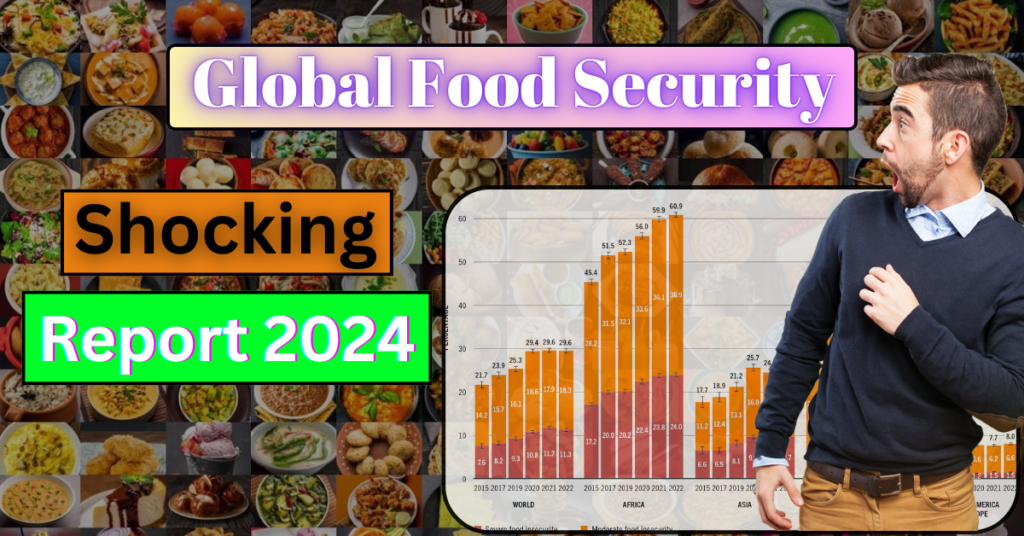
Global Food Security Report: Key Insights and Challenges
In recent years, the issue of global food security has garnered increasing attention, particularly in light of recent findings presented at the G20 summit. Despite notable strides toward alleviating hunger, regions such as Latin America and the Caribbean remain severely impacted by issues related to food insecurity. This blog delves into the key findings of the latest Global Food Security Report 2024, examining the ongoing challenges, regional disparities, and the interplay of climate change and economic instability on food security.
Understanding Global Food Security Report
Food security refers to the availability, access, and utilization of food that meets the dietary needs and preferences of individuals. It is a multifaceted issue involving factors such as agricultural productivity, economic stability, climate conditions, and social infrastructure. According to the recent Global Food Security Report, while some progress has been made, several regions are still grappling with severe food insecurity.
Key Findings from the Global Food Security Report 2024
The Global Food Security Report 2024 provides an in-depth analysis of the current state of food security worldwide. Here are some of the most significant findings:
1. Escalation of Food Insecurity: Despite ongoing efforts to combat hunger, food insecurity has worsened in several regions. According to the report, approximately 10% of the global population is experiencing severe food insecurity, a rise from previous years.
2. Regional Disparities: The report highlights stark disparities in food security across different regions. Sub-Saharan Africa and parts of South Asia are particularly hard-hit, with high levels of malnutrition and food scarcity.
3. Impact of Climate Change: Climate change continues to be a major driver of food insecurity. Extreme weather events, such as droughts and floods, are becoming more frequent and severe, disrupting agricultural production and food supply chains.
4. Economic Factors: Economic instability, including inflation and unemployment, has exacerbated food insecurity. Rising food prices are making it increasingly difficult for low-income families to access nutritious food.
5. Progress and Innovations: On a positive note, the report also highlights several successful initiatives and innovations in agriculture and food distribution that have shown promise in improving food security in certain areas.
Regional Focus: Challenges and Solutions
1. Sub-Saharan Africa
Challenges:
- Conflict and Instability: Ongoing conflicts and political instability are major barriers to food security in many Sub-Saharan countries.
- Climate Variability: Frequent droughts and unpredictable weather patterns are severely affecting crop yields.
Solutions:
- Enhanced Agricultural Practices: Investment in climate-resilient crops and sustainable farming techniques can help improve agricultural productivity.
- Conflict Resolution: Efforts to address underlying conflicts and improve governance can create a more stable environment for food security initiatives.
2. South Asia
Challenges:
- Population Growth: Rapid population growth is putting additional pressure on food resources.
- Nutritional Deficiencies: High levels of malnutrition and micronutrient deficiencies are prevalent in the region.
Solutions:
- Nutrition Programs: Expanding access to nutrition programs and improving dietary diversity can address nutritional deficiencies.
- Sustainable Agriculture: Promoting practices such as crop diversification and soil conservation can enhance food production.

3. Latin America and the Caribbean
Challenges:
- Economic Inequality: Economic disparities and political instability are contributing to high levels of food insecurity.
- Climate Risks: The region is vulnerable to climate change impacts, including extreme weather events and changing weather patterns.
Solutions:
- Economic Support: Implementing social safety nets and economic support programs can help vulnerable populations access food.
- Climate Adaptation: Investing in climate adaptation measures and sustainable agricultural practices can mitigate the effects of climate change.
Actionable Strategies for Improving Global Food Security
1. Invest in Agricultural Innovation
Investing in agricultural research and technology is crucial for improving food security. Innovations such as drought-resistant crops, precision farming, and efficient irrigation systems can help increase food production and resilience to climate change.
2. Strengthen Global Food Systems
Building resilient food systems involves improving infrastructure, reducing food waste, and enhancing supply chain efficiency. Strengthening these systems can ensure a more stable and reliable food supply.
3. Promote Sustainable Practices
Sustainable agricultural practices, such as organic farming, agroforestry, and conservation tillage, can improve soil health, increase biodiversity, and reduce the environmental impact of food production.
4. Support Economic Stability
Addressing economic factors that contribute to food insecurity is essential. This includes implementing policies to control inflation, reduce unemployment, and support low-income households.
5. Enhance International Cooperation
Global challenges require global solutions. Strengthening international cooperation through partnerships, knowledge sharing, and coordinated responses can help address food security issues more effectively.
Conclusion
The Worldwide Food Security Report highlights the intricacy of tending to food frailty in a world impacted by environmental change and financial flimsiness. While some headway has been made, huge difficulties remain, especially in weak districts like Latin America and the Caribbean.
- Tending to these difficulties requires a complex methodology, including maintainable horticultural practices, financial help, foundation improvement, and worldwide collaboration. By getting it and resolving these issues, we can make progress toward a safer and impartial worldwide food system.
- As we explore the intricacies of the 21st hundred years, worldwide food security remains quite possibly one of the most major problems on the global plan. The Worldwide Food Security Report 2024 has quite recently been delivered, and it portrays the difficulties and progress in the battle against hunger.
- This blog entry will investigate the vital discoveries of the 2024 report, feature basic local issues, and recommend significant procedures for further developing worldwide food security. The Worldwide Food Security Report 2024 highlights the intricacy of the worldwide food security challenge.
- While progress has been made, huge issues remain, especially in areas confronting intense food uncertainty. By putting resources into horticultural development, reinforcing food frameworks, advancing feasible works, supporting monetary steadiness, and upgrading global collaboration, we can make progress toward a safer and impartial food future for all.
- An opportunity to act is currently — our aggregate endeavors can have an effect in making an existence where everybody approaches adequate, nutritious food.

FAQ
1. What are the main findings of the recent Global Food Security Report?
- Persistent Hunger: Despite global efforts, hunger persists, particularly in Latin America and the Caribbean. The region has seen a rise in food insecurity due to economic challenges and political instability.
- Climate Change Impact: Climate change continues to exacerbate food insecurity by affecting agricultural productivity. Extreme weather events, such as droughts and floods, disrupt food supply chains and reduce crop yields.
- Economic Instability: Economic downturns, inflation, and political unrest contribute to food insecurity by limiting access to affordable and nutritious food.
- Nutritional Quality: Many regions are not only facing food shortages but also issues related to the quality of food available. Malnutrition and micronutrient deficiencies remain prevalent.
- Progress and Challenges: While some areas have made progress in reducing food insecurity, others lag behind due to a combination of local and global factors.
2. How does climate change affect global food security?
- Altered Weather Patterns: Changes in temperature and precipitation patterns can lead to reduced crop yields and increased vulnerability to pests and diseases.
- Extreme Weather Events: Increased frequency of extreme weather events, such as hurricanes and droughts, can destroy crops, disrupt food supply chains, and damage infrastructure.
- Rising Sea Levels: Coastal areas face threats from rising sea levels, which can lead to saltwater intrusion and loss of arable land.
- Resource Scarcity: Climate change can exacerbate water scarcity, affecting irrigation and crop production.
3. What role does economic instability play in food insecurity?
- Inflation: Rising food prices due to inflation can make it difficult for low-income households to afford sufficient and nutritious food.
- Unemployment: Economic downturns can lead to higher unemployment rates, reducing household incomes and purchasing power.
- Political Unrest: Economic instability often correlates with political unrest, which can disrupt food distribution networks and exacerbate food shortages.
- Trade Barriers: Economic policies and trade barriers can restrict access to food imports, further impacting availability and affordability.
4. What are the specific challenges faced by Latin America and the Caribbean regarding food security?
- Economic Disparities: Economic inequality and political instability have led to high levels of food insecurity in several countries.
- Climate Vulnerability: The region is highly vulnerable to climate change impacts, such as hurricanes, droughts, and floods, which affect agricultural productivity.
- Nutritional Deficiencies: There is a high prevalence of malnutrition and micronutrient deficiencies, partly due to poor dietary diversity and limited access to nutritious foods.
- Infrastructure Issues: Weak infrastructure and logistical challenges impede efficient food distribution and access.
5. What measures can be taken to improve global food security?
- Sustainable Agriculture: Promoting sustainable agricultural practices can help mitigate the effects of climate change and increase food production resilience.
- Economic Support: Providing economic support and social safety nets can help mitigate the impact of economic instability on food security.
- Investment in Infrastructure: Investing in infrastructure improvements, including transportation and storage facilities, can enhance food distribution and reduce losses.
- Policy Reform: Implementing policies that address both local and global factors contributing to food insecurity is essential for long-term solutions.
- International Cooperation: Collaborative efforts among nations and organizations can facilitate resource sharing, knowledge exchange, and coordinated responses to food crises.
Important Links:-
- SCO Offical Websites:- The Shanghai Cooperation Organisation
- HomePage :- Hindi main khoj


